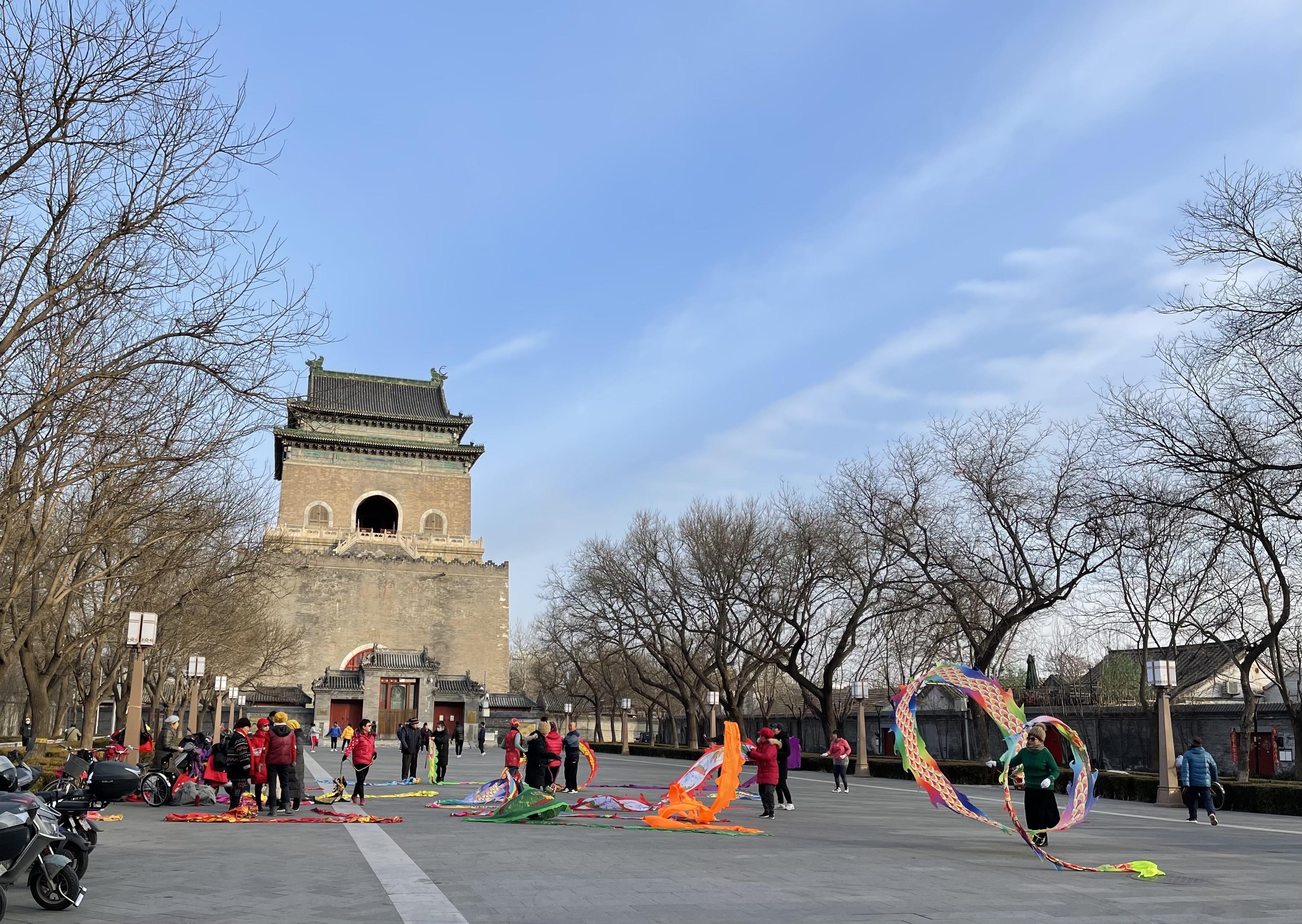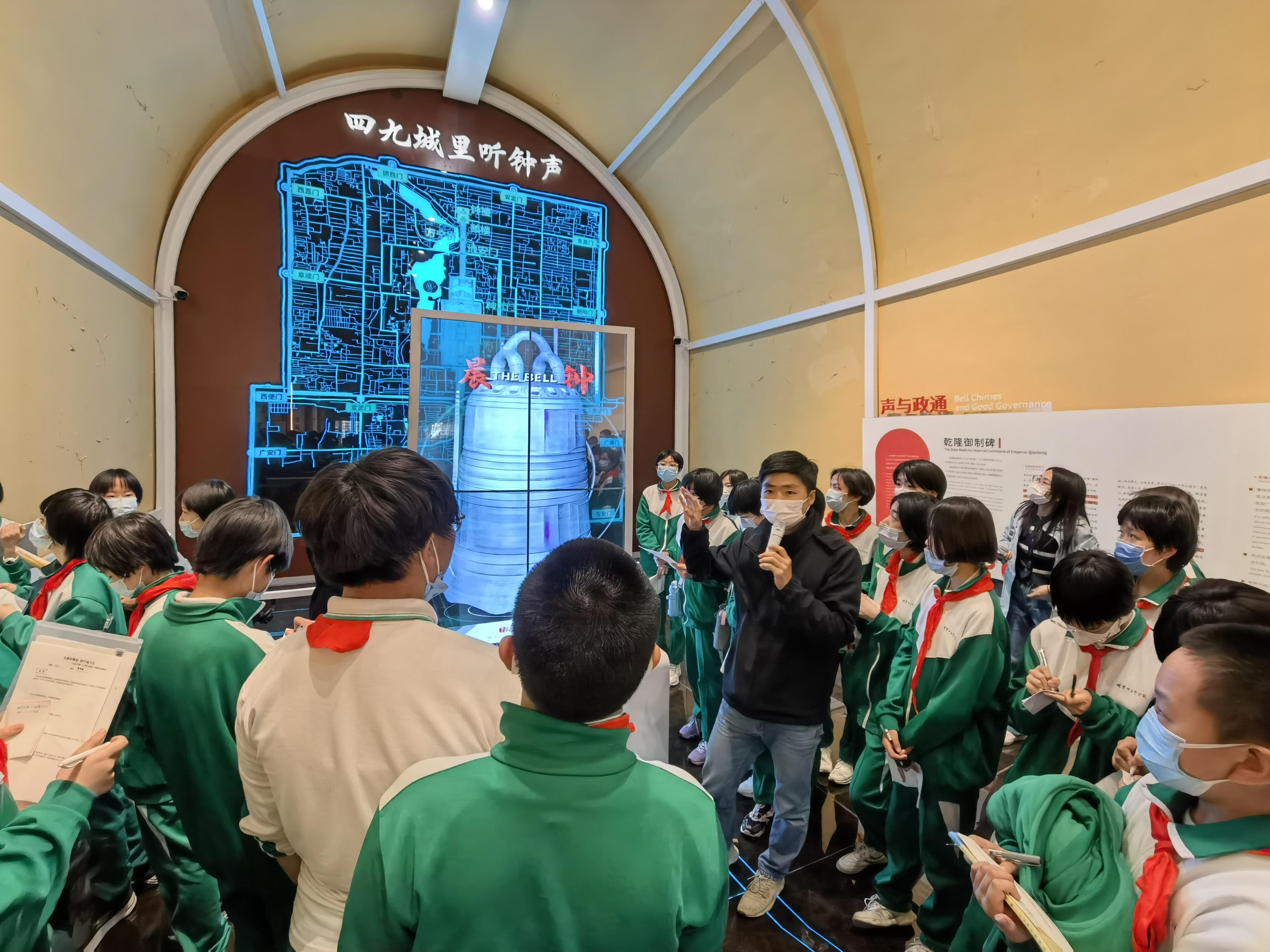Exhibitions, activities targeting modern sensibilities and rising interest in heritage swell daily number of visitors to Beijing attractions, Yang Feiyue reports.
 Residents dance on the square between the Bell and Drum towers in Beijing. (PHOTO PROVIDED TO CHINA DAILY)
Residents dance on the square between the Bell and Drum towers in Beijing. (PHOTO PROVIDED TO CHINA DAILY)
At the northern end of Beijing's Central Axis, two ancient buildings are casting a renewed spell over modern visitors.
The red-walled and gray-tiled Drum Tower rises about 100 meters to the south of the gray-walled Bell Tower. Both were built during the Yuan Dynasty (1271-1368) and served as the capital's center of timekeeping through the Ming (1368-1644) and Qing (1644-1911) dynasties.
Thanks to the protection of the Central Axis, the surroundings of the Bell and Drum towers have improved, more people are coming to visit, and the area’s cultural heritage has come to life.
Wang Jinming, local resident
The two buildings are considered the biggest and the best preserved of their counterparts around the country, according to the cultural heritage management institute for the Beijing Bell and Drum towers.
Ascend to the top of the Bell Tower and look to the north, and the Olympic Tower looms on the horizon, while the view from the Drum Tower is a stunning panorama over the old imperial park at Jingshan.
Wang Shuaiqi is busier than usual these days. The summer vacation is here, and the two towers he watches over have been attracting more than 2,000 visitors a day.
"Visitors have almost doubled," says Wang, who has worked at the cultural heritage management institute responsible for the towers for just over two years.
Getting to the top of the towers means taking the stairs. They are steep and pose a challenge to many visitors, especially as each tread is almost 50 centimeters high, nearly twice the height of most ordinary stairs.
While visitors warily make their way up at a glacial pace, Wang speeds to the top effortlessly, showing them how it's done.
"You get used to it after a bit of practice," he says.
The bigger crowds mean work is more exacting for Wang and his colleagues.
"We have to be prepared for every eventuality, and take measures to ensure that every visitor has a nice experience," he says.
Wang himself visited the towers a number of years ago as a tourist.
"My impression then was mainly at the sensory level," he recalls. "It was tiring climbing the stairs, but once I reached the top, the views were beautiful."
It was this experience that prompted him to take a job at the heritage management institute when an opportunity opened up in 2021.
"I know the Bell and Drum towers are important historical buildings on the Central Axis, and I'm interested in traditional culture," he says.
 Two members from the cultural heritage management institute for the towers measure the wall width as they monitor various parts of the structures. (PHOTO PROVIDED TO CHINA DAILY)
Two members from the cultural heritage management institute for the towers measure the wall width as they monitor various parts of the structures. (PHOTO PROVIDED TO CHINA DAILY)
Over the last two years, Wang has come to know every aspect of his wards, from their exact heights down to the number of steps.
"I often find myself thinking about the specifics of different parts of the towers when I see them. For example, when I stand at the bottom of the Drum Tower staircase, the number 69, the number of steps up, usually pops into my head," he says.
Wang sees these unconscious connections as being the result of the positive influence of the senior cultural heritage guardians at the institute, which was set up in 1985 and has been responsible for the daily operation, protection, and revitalization of the towers ever since.
Like many of his colleagues, Wang's responsibilities include monitoring the two buildings and the relics they contain, to track their condition.
"This involves all kinds of things, from the impact of dust on the ability of visitors to see the cultural relics, to monitoring settlement of the structures, even removing a single weed," he explains.
In addition to daily patrols, the towers are given a more thorough inspection every quarter.
The guardians note their observations, take photos, and write reports about key parts.
"We then collate the information and create an archive of firsthand observations for the protection of cultural heritage," Wang says.
Since August last year, he has taken on responsibility for leading the tours of the immersive digital exhibition that takes visitors back to the time when the capital's residents relied on the towers to organize their daily lives.
"I walk them through the historical evolution of the Bell and Drum towers, their different missions during different historical periods, as well as the different kinds of timekeeping instruments that were used, and how they worked," Wang explains.
He paints a vivid picture of historical timekeeping, as well as of the architectural features of the two towers, and of the folk customs and life in the surrounding neighborhoods.
There is a display of historical objects used to tell the time, and interactive experiences, including recordings of old street peddlers, also help bring the past and ancient methods of telling the time to life.
One part of the exhibition is an overview of the Central Axis, with details of the historical jewels along its length.
Wang says that he can feel the public interest in the history of the towers, as daily visitor numbers have almost tripled since the exhibition opened, and adds that although the towers are no longer in practical use, their cultural value is rising.
 Wang Shuaiqi from the management institute gives visitors a tour of the Drum Tower. (PHOTO PROVIDED TO CHINA DAILY)
Wang Shuaiqi from the management institute gives visitors a tour of the Drum Tower. (PHOTO PROVIDED TO CHINA DAILY)
The long reign of the towers as timekeepers came to an end in 1924, when Pu Yi, the last emperor of the Qing Dynasty, was expelled from the Forbidden City, and the towers were silenced.
The following year, the Drum Tower was turned into a museum displaying objects from the Eight-Nation Alliance's invasion of Beijing in 1900 and the May 30 Massacre in Shanghai, while the Bell Tower was turned into a cinema that served as an adjunct to the museum.
The transformations brought all kinds of people to the area, from street peddlers to performers, and created a lively, bustling atmosphere.
In the 1980s, after extensive renovations, the Bell and Drum towers were reopened to the public, which led to a boom in the fortunes of the surrounding areas, and an increase in public activity.
On Dec 31, 2001, the tradition of ringing the bell at dawn and beating the drum at dusk was revived for special occasions, and the towers, which had been silent for nearly a century, regained their ancient purpose.
Wang Jinming has lived his entire life in the surrounding neighborhood and has seen the way it has changed over the years.
Of his own volition, the 60-something visits the square between the two towers every day and tells curious tourists stories about them, and the nearby alleys and lanes.
"Thanks to the protection of the Central Axis, the surroundings of the Bell and Drum towers have improved, more people are coming to visit, and the area's cultural heritage has come to life," Wang Jinming says, adding that many young people come to take photos and shoot videos.
Zuo Yanjie, who has been working at the management institute for nearly two decades, believes that the rising popularity of the two towers is to be expected as the neighborhood has long been a cultural hub, as well as the backdrop for many influential works of literature and films.
"In fact, the Bell and Drum towers have always been popular," Zuo says, adding that the public desire to know about the capital's long history and traditional Chinese culture is responsible.
That desire has found a fresh outlet in the new experiences rolled out by the institute.
Since last year, postcard check-ins to encourage visitors to learn about key parts of the towers, and creative cultural products like themed icecreams and learning tours have been introduced to cater to modern tastes, while showing people the charm of the two historical structures.
As a cultural heritage worker in the new era, Zuo believes that finding innovative ways to promote cultural heritage, while ensuring its preservation, is essential.
"By finding the connections between traditional culture and modern life, we can truly integrate historical and cultural elements into our daily lives," she says.
Contact the writer at yangfeiyue@chinadaily.com.cn


